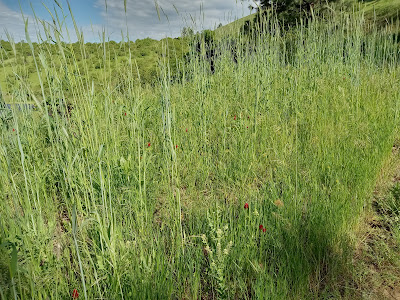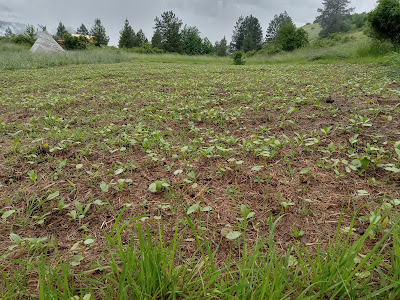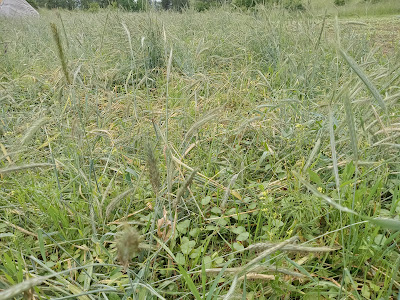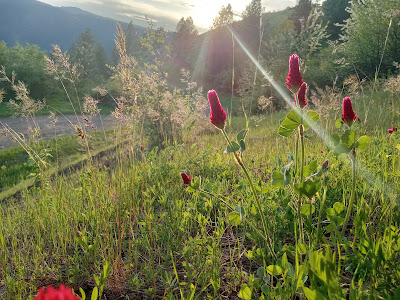Another growing season is coming to an end at Hunter's Eden Homestead. This season I decided to focus mainly on planting perennial species in my plots and while most of them have turned into successes, the few failures we have had have become important learning experiences that will help us design our plots in the future.
In early spring in our main large food plot we planted a pretty diverse mix of perennial species which included cicer milkvetch, crownvetch, small burnet, blue flax, chicory, alfalfa, falcata alfalfa, aberlasting clover and birdsfoot trefoil. This mix did very well for the most part. However the cicer milkvetch and the crownvetch did not do as well due to being outcompeted by the faster growing alfalfas and aberlasting clover, which were planted at much too high of a rate for the planting. This next year's plot we will remove them from the seed mix altogether and increase the rate of the cicer milkvetch and the crownvetch so they will have a better chance at establishing. We also decided to remove the birdsfoot trefoil from future mixes due to its low forage preference. Also something interesting that happened in this plot was that both the cereal rye and the german millet from last year reseeded and did quite well. This means that I will probably add these annuals into most of my future mixes because of their reseeding abilities and high forage value during hunting season. Another thing that happened in this plot was that it had a lot of perennial grass weeds come up in it either from the tarps not getting a complete kill or from grass seed blowing in from adjacent grass areas. Because of this I had to mow this plot several times to keep the grass from going to seed. I also mowed the perimeter of the food plots and current tarped areas in order to prevent grass from seeding into the new upcoming plot once the tarp is removed. Hopefully this will help prevent grass establishment in next year's plot so mowing would be less necessary. I also decided to leave the tarps down all growing season (March- October) to get a complete kill of the sod.
Later in the fall we are planning on expanding this food plot and we will dormant seed it with a new mix that includes cicer milkvetch, crownvetch, small burnet, blue flax, chicory, little bluestem, big bluestem, switchgrass and basin wildrye. We are choosing the legumes and forbs in this mix because they are highly preferred forages that should still be green and palatable during our fall and early winter hunting seasons. The bunch grasses in this mix were chosen for thier vigorous growth to add organic matter to the soil and to help keep out less desirable sod forming grass species as well as to provide forage for wildlife and livestock. Also next year after this plot is mostly established I will likely add in some of the other more aggressive species such as cereal rye, german millet, forage plantain, alfalfa, aberlasting clover and red clover. By splitting the mix up and planting the more aggressive species the second year I can hopefully ensure that the less aggressive species have time to establish without being outcompeted and hopefully I will still end up with a highly diverse plot with all of the species being represented.
This year we also created a new plot on the dry hillside above our pond. We burned off the vegetation in the early spring then seeded it with cicer milkvetch, alfalfa, falcata alfalfa, small burnet, blue flax, birdsfoot trefoil and aberlasting clover. After broadcasting the seed we harrowed the seed into the soil by hand by dragging the harrow across the hillside. This plot did not do very well because of competition with already established weeds such as sulfer cinquefoil, canada bluegrass, medusahead and yellow starthistle. Also this is a very dry site because of it's steep southern exposure. During the summer I mowed it twice to reduce weed pressure and I believe that helped somewhat. We will see what all comes back next spring but I believe we got some decent establishment from the small burnet, blue flax and possibly some of the alfalfa. I will probably plant a high rate of cereal rye here this fall just to have something green growing during the hunting season and to improve the organic matter on the plot. At some point I may also try to plant basin wildrye here as it is a large robust and drought tolerant perennial cool season bunchgrass that should do well here and be able to help build the soil.
Another area we seeded this spring was an area I had cleared out as a firebreak on the border of our property. Most of it already had established perennial grasses but some of it was bare ground where I had cut back shrubs and small trees such as roses and hawthorns. In these areas there was enough bare ground where I could broadcast and rake in our seed mix. I used the same mix I seeded onto the hillside plot. In this area, however, most of the species I planted seemed to establish quite well especially in areas that were partly shaded by adjacent trees and brush. The soil here also seemed to be richer and more moist. This area probably had the best establishment of cicer milkvetch out of all the areas I planted this year so that was encouraging to see.
The last area we planted was along the roadside on the top end of our property that used to be almost pure starthistle, but that we had removed the majority of it by weed-eating it the last few summers. We also planted it with the same mix we used on the hillside plot and the property line plot. This mix did not do well due to being outcompeted by weeds, mostly annual grasses. Also our chickens that we free range kept getting into this area and scratching up the newly established seedlings which didn't help anything. This fall I will likely broadcast basin wildrye onto this plot in order to create a visual barrier for our property from the road. If this species was able to establish it should be able to create a "plot screen" effect that habitat managers in the east use switchgrass for when they are designing corridors to sneak to a blind or treestand in order to not be detected by deer. If this is successful then I could see using it for the same purpose on my plots in the future, but I will test it out on the roadside first.
This year has been another busy one, but productive as well. And this fall I am planning on continuing my food plot progress by expanding plots and planting new areas. And next spring I will tarp grass areas that I will be able to plant the following year. Slowly but surely I am turing our property into a hunting paradise and I am learning a ton along the way that could help give me the knowledge to help other's do the same on thier properties. One day I'd love the chance to help others make their hunting property dreams come true and I'd ideally like to make a career out of it some day. But for now I'm still learning the on the ground lessons that I will need to gain in order to have the wisdom to become a master of wild game habitat management.
















.jpeg)



















